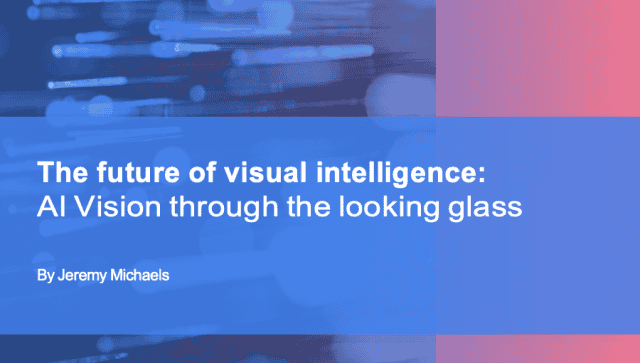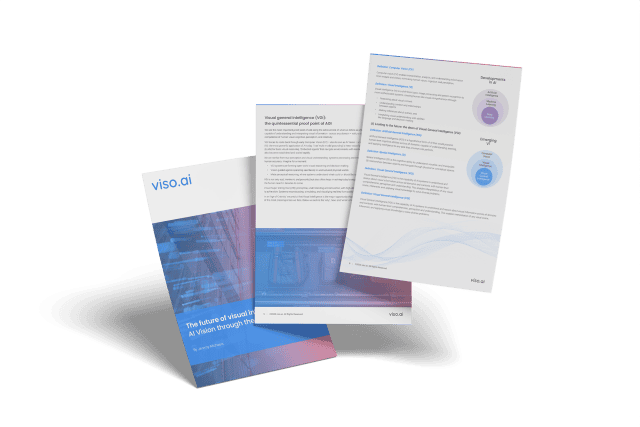On Thursday, 25th September 2025, our very own Talia Bender and Jeremy Michaels officially launched the new whitepaper, proudly announcing the dawn of Visual General Intelligence (VGI) to the world.
This is the fourth of six articles covering all six sections of the whitepaper, “The Future of Visual Intelligence: AI Vision Through The Looking Glass,” which includes our belief that VGI is the quintessential proof point of Artificial General Intelligence (AGI). Crucially, it outlines the role VGI plays in accelerating the paths to zero downtime and zero harm.
You can now download the whitepaper and enjoy our on-demand webinar with our founders, Nico Klingler and Gaudenz Boesch, as they step us through what VGI is and why it matters. In this article, we summarize the fourth section of that whitepaper.

“While we’re stuck debating whether machines can think like humans, we are missing the profound truth that the real revolution won’t come from artificial minds that can reason… but from artificial eyes that can see better than humans ever could.”
– Gaudenz Boesch (co-Founder and co-CEO @ viso.ai)
Why the past doesn’t dictate the future
Every technological wave begins with pioneers, proof-of-concepts, and point solutions. In the early days of computer vision, progress was measured in pixel matches and rigid rules. Systems could detect anomalies only in tightly controlled environments: factories with standardized lighting and repetitive tasks.
Then came deep learning. Neural networks revolutionized pattern recognition, enabling more robust detection and recognition across diverse inputs. But even these systems carried limits: data-hungry training cycles, costly infrastructure, and narrow scope applications.
The story of AI vision could have stopped there, limited to incremental improvements. But the past does not dictate the future. A new paradigm is emerging, Visual General Intelligence (VGI), that transforms vision systems from brittle, task-specific tools into adaptive, context-aware, and scalable platforms.
This blog, adapted from The Future of Visual Intelligence: AI Vision Through the Looking Glass, explores why VGI represents the true game-changer in AI.

The founder’s view: moving beyond fixed-function
In any wave of innovation, the first adopters often settle for fixed-function tools. These solutions solve immediate problems but lack flexibility for the future. Many early AI vision deployments fit this mould: single-purpose models that cannot adapt as environments or requirements change.
The problem? Industries are not static. Factories retool, construction sites evolve, and waste streams vary. Rigid systems cannot scale in dynamic contexts.
As viso’s founders argue, the next phase of AI vision demands extensibility, security, and adaptability. That means platforms, not point solutions. Intelligence engines that don’t just detect objects but understand what they see and decide what to do next.

Turning point: from Computer Vision to Visual Intelligence
The leap from traditional Computer Vision (CV) to true Visual Intelligence (VI) was made possible by deep learning, foundation models, and affordable, high-performance hardware.
Unlike older systems, VI brings:
- Contextual reasoning: understanding the relationships between objects, not just their presence
- Flexible adaptation: handling new conditions without starting from scratch
- Integration with decision-making: linking vision to language, planning, and action
And yet, even VI is only the midpoint. VGI goes further: enabling systems to perform any visual task across any domain with human-level comprehension.
A case study: the DeepSeek leapfrog
To understand the disruptive potential of VGI, consider the case of DeepSeek, a startup that redefined the economics of AI.
While GPT-4 required an estimated $3 billion in training costs, DeepSeek achieved comparable performance with just $5.6 million. How? By embracing efficiency in architecture, training, and deployment:
- Mixed precision frameworks reduced computational load
- Mixture-of-Experts (MoE) architecture cut training costs to 1/18th of GPT-4
- Deployment pricing was 90% cheaper and consumed 92% less energy
The implications are profound. If such leapfrogging is possible in language models, similar breakthroughs could make advanced visual intelligence economically accessible to all – from startups to global enterprises.
This democratization would accelerate the timeline to VGI while breaking the assumption that only trillion-dollar budgets can shape the frontier.

The technological enablers of VGI
Several converging forces are making VGI viable:
Foundation models
Large Vision Models (LVMs) extend the foundation model approach to vision, enabling multi-task adaptability without extensive retraining.
Hardware evolution
Affordable GPUs, AI-specific chips, and edge computing make real-time deployment scalable and cost-effective.
Architectural innovation
Mixed precision, MoE, and modular frameworks reduce both costs and energy consumption.
Human-in-the-Loop feedback
Continuous correction and adaptation ensure models improve dynamically in real-world conditions.
Together, these breakthroughs mark a turning point: VGI is no longer locked in research labs but is entering mainstream deployment.
Ripples in the pond: implications beyond vision
The shift to VGI is not just a technological improvement: it’s a strategic inflection point. Unlike traditional models that require siloed retraining, VGI systems are:
- Self-improving: learning continuously through weakly supervised and self-supervised techniques
- End-to-end integrated: covering everything from data ingestion to application-level orchestration
- Globally scalable: enabling edge-based deployment across thousands of devices
This democratization of visual intelligence will compress innovation cycles and create new industries, much as the app ecosystem did for smartphones.
From pixel matching to adaptive understanding
The contrast between the old and the new is stark:
- Then: strict rules, brittle models, endless retraining
- Now: adaptive systems that generalize from limited data, understand context, and update dynamically
Deep learning was a step forward, but not the finish line. VGI takes us beyond static pattern recognition to adaptive understanding: a system that sees not just what is, but what it means.

Why VGI is the #1 game changer in AI
Among the many advances in AI (language models, robotics, predictive analytics), why does VGI stand out as the most transformative? We see four reasons:
- Adaptability: VGI systems can flex across use cases, environments, and industries
- Data efficiency: self-supervised learning reduces reliance on massive, annotated datasets
- Feedback loops: human-in-the-loop design accelerates continuous improvement
- Integration: end-to-end orchestration transforms vision into actionable intelligence
Together, these dimensions make VGI the most powerful and versatile form of AI today: a capability with impact far beyond any single sector.
The five pillars of VGI architecture
To deploy VGI at scale, organizations need more than models. They need a framework. The whitepaper outlines five pillars:
- Model: Large Vision Models (LVMs)interpreting inputs across contexts
- Application layer: connecting vision insights to workflows and decisions
- Deployment architecture: edge-based computing enabling instant, scalable processing
- Configuration tools: remote, flexible customization across environments
- Continuous interaction: human feedback ensuring adaptive, self-improving systems
This holistic stack transforms vision from a research capability into a strategic business asset.
Dashboards and analytics: turning vision into intelligence
Raw detection is not enough. Organizations need insights that drive change. VGI platforms deliver dashboards that visualize compliance, safety, efficiency, and trends over time.
These analytics enable:
- Auditable evidence for compliance and insurance
- Strategic decision-making grounded in real-world data
- Cultural change as teams respond to visible, actionable insights
In this way, VGI is not just about seeing the world differently: it’s about running organizations differently.

Why download the whitepaper?
This blog has outlined why VGI is the true game-changer in AI, moving us from brittle models to adaptive intelligence. But the full whitepaper dives deeper:
- Case studies like DeepSeek that illustrate cost efficiency and scalability
- Technical analysis of modular architectures and human-in-the-loop feedback
- A complete framework for deploying VGI across industries
👉 Download The Future of Visual Intelligence: AI Vision Through the Looking Glass to see how your organization can harness VGI to stay ahead of the curve.
